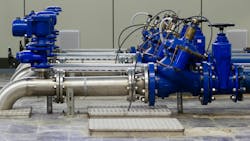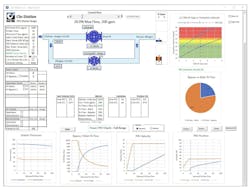Developing valve software for the water industry: From slide rules to smart solutions
Key Highlights
- Specialized software automates complex hydraulic calculations, reducing human error and improving system design accuracy.
- Development emphasizes domain expertise, ensuring tools are scientifically rigorous and aligned with engineers' workflows.
- Transitioning from desktop to web platforms enhances accessibility, collaboration, and real-time analysis capabilities for water industry professionals.
Precision isn't just important in water infrastructure, it's critical to reliable operations and safety. For valves, every pressure calculation and system design decision, like size, type and placement of every valve can impact entire communities' access to clean, reliable water. Yet for decades, civil engineers working on water infrastructure projects have relied on slide rules, printed charts, and the expertise of salespeople to make these crucial calculations.
As the water industry incorporates more technology and IoT, some manufacturers, like Cla-Val are developing free specialized software to improve every facet of the product life from procurement to operations to maintenance and even predictive analysis.
Identifying the problem
Software design often begins with a simple recognition that the existing methods aren't meeting users' needs – slide rules and charts are timely and can be prone to human error if not factoring in all system conditions.
Roger Lah, one of the program developers of Cla-Tools, a web-based software suite that helps application engineers, select and analyze automatic control valves, explained, "For such a vital piece of infrastructure to be using paper charts and cross referencing with specs and other system components, we saw a need to automate engineering computations. From a simple starting point, software has a way of snowballing into more features and tools that make it easier to use and offer more functionality. It’s a very exciting and rewarding process.”
Each program in Cla-Tools addresses specific questions that water engineers face daily:
What size valve should I use for this application?
How can I solve potential cavitation problems before they occur?
What are the consequences of using a valve that's too small or too large?
How will performance change if upstream or downstream pressures fluctuate?
What's the optimal combination of parallel valves for a pressure reducing station?
How do I balance flows between lead and lag valves to avoid excessive velocities?
The technical foundation: Where engineering meets code
What makes developing software for highly specialized industries unique, is the importance of domain expertise over pure programming skills. When building tools for water system engineers, understanding system hydraulics can be more valuable than mastering the latest development frameworks. "Understanding the application from a civil engineer's perspective was a primary driver of the App’s development," says Lah.
This philosophy fundamentally shaped their technology choices to create applications that matched how engineers think and work. The technical foundation drew heavily from established academic sources, ensuring that the software wasn't just user-friendly, it was scientifically rigorous.
Navigating development challenges
Creating reliable engineering software for water systems presents unique technical hurdles:
Data integration and validation: Development teams must gather extensive technical information from laboratory tests and field studies. This involves more than simply digitizing existing data, it requires implementing hydraulic modeling based on empirical results to provide realistic, actionable outputs.
Visualization of complex calculations: Engineers are visual thinkers, but hydraulic calculations can be extraordinarily complex. One of the challenging aspects of development is creating intuitive dynamic charts that translate mathematical complexity into clear, understandable graphics that support decision-making.
Real-world application modeling: Academic calculations often work in isolation, but real-world systems are interconnected. Software must model how individual components perform within complete systems, allowing engineers to assess how their design choices will perform in actual installations.
Balancing customization and stability: Striking a balance between customization for individual clients and maintaining a stable core product can be challenging. Flexibility needs to be built into the software to accommodate uncommon solutions and allows user feedback to drive upgrades.
The user-centric approach
Specialized software development requires constant dialogue with end users. Lah notes that in technical fields like water valve engineering, this feedback becomes the primary driver of meaningful improvements.
“Sales agents, civil engineers, and other industry professionals provided continuous input that shaped feature development in Cla-Tools and guided upgrades,” said Lah. This user-centric approach led to highly specific functionality that might seem minor to outsiders but is valuable for daily users. For instance, a seasoned user, requested a specific "Add KO" button that would allow engineers to more easily compare valve performance with and without Anti-Cavitation trim. That feature was incorporated because it solved an issue at the right point of the decision-making process.
Accessibility and security
As desktop software proves its value, the next challenge is to make it accessible to global audiences. The transition from desktop applications to web platforms requires more than simple conversion. Programs have to be completely "bulletproofed" for web use, often requiring partnerships with specialists in application conversion. This process needs to preserve all the functionality of desktop versions while ensuring reliability in online environments, including tablets and phones.
Given the critical role of these tools in water management, ensuring their security, accuracy, and reliability is non-negotiable. Hosting programs on secure, independent servers and employing proven sign-in processes are standard practices to maintain integrity.
The shift to web-based accessibility has fundamentally changed how engineering tools are integrated into industry workflows. “Engineers worldwide can now access Cla-Tools instantly, transforming not just individual project work but also sales processes, training programs, and collaborative design efforts,” says Lah.
Sales presentations routinely include live analysis of client-specific challenges, allowing immediate demonstration of how different design choices affect system performance. This real-time capability has elevated technical discussions and improved decision-making processes across the industry.
More software to come
Development teams increasingly see artificial intelligence as a transformative force for specialized software. Rather than continuing workflows that adapt desktop applications for web use, AI tools promise to enable direct development for modern platforms, streamlining the entire development process. However, the day-to-day user needs remain the same.
Building programs that address everyday processes has never been easier and having manufacturers, with a lifetime of expertise, build and provide these tools free to customers is a win-win. It allows engineers and operators to know the intricacies of their systems better and make the right decisions for long term success.
About the Author

Mark Gimson
Mark Gimson is Director of Marketing and International Sales for Cla-Val. As a mechanical engineer with 40 years in the water industry, Mark has a passion for expanding markets and understanding customer challenges to provide the optimal solution.

